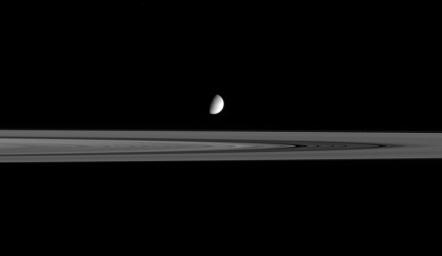
|
Iceball Among Snowballs
- Click the image above for a larger view
- Full-Res JPEG (791 x 458) (10.2 kB)
- Full-Res TIFF (791 x 458) (362.9 kB)
Caption:
The moon Enceladus seems to hover above the outer reaches of Saturn's B ring. Below and to the right of Enceladus, four faint bands lie in the center of the dark Cassini Division.
Recently, scientists have speculated that the particles that make up the dense B and A rings might be more like fluffy snowballs than hard ice cubes. The conclusion is based on temperature data obtained by the Cassini spacecraft.
Enceladus' diameter is 505 kilometers (314 miles). The icy moon is on the near side of the rings in this view.
This image was taken in visible light with the Cassini spacecraft narrow-angle camera on Sept. 15, 2005, at a distance of approximately 2.3 million kilometers (1.4 million miles) from Enceladus. The image scale is 14 kilometers (9 miles) per pixel on Enceladus.
Background Info:
The Cassini-Huygens mission is a cooperative project of NASA, the European Space Agency and the Italian Space Agency. The Jet Propulsion Laboratory, a division of the California Institute of Technology in Pasadena, manages the mission for NASA's Science Mission Directorate, Washington, D.C. The Cassini orbiter and its two onboard cameras were designed, developed and assembled at JPL. The imaging operations center is based at the Space Science Institute in Boulder, Colo.
For more information about the Cassini-Huygens mission visit http://saturn.jpl.nasa.gov . The Cassini imaging team homepage is at http://ciclops.org .
Cataloging Keywords:
| Name | Value | Additional Values |
|---|---|---|
| Target | Enceladus | A Ring, B Ring, Cassini Division, Saturn Rings |
| System | Saturn | |
| Target Type | Satellite | Gap, Ring |
| Mission | Cassini-Huygens | |
| Instrument Host | Cassini Orbiter | |
| Host Type | Orbiter | |
| Instrument | Imaging Science Subsystem (ISS) | |
| Detector | Narrow Angle Camera | |
| Extra Keywords | Grayscale, Visual | |
| Acquisition Date | ||
| Release Date | 2005-10-31 | |
| Date in Caption | ||
| Image Credit | NASA/JPL/Space Science Institute | |
| Source | photojournal.jpl.nasa.gov/catalog/PIA07619 | |
| Identifier | PIA07619 | |
